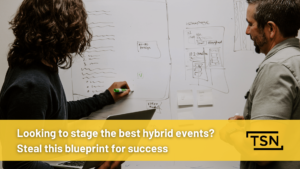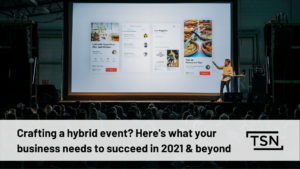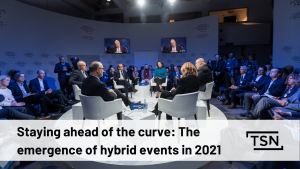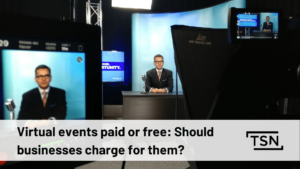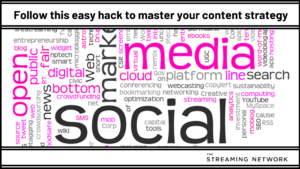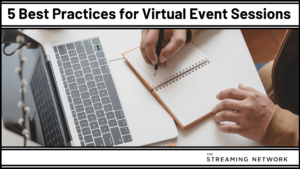Podcast: Play in new window | Download | Embed
Subscribe: Apple Podcasts | Google Podcasts | RSS
Last time, on “The Webinar: Lessons From The Front Line”, we discussed how to qualify leads in your sales pipeline, as in where they are in your sales funnel.
In the latest episode, we’re going to take a step back and look at how to get new leads into your sales pipeline and increase your webinar viewership.
It’s important to understand your audience in order to understand where they are in your sales pipeline. This way, you can convey the right message, at the right time, to the right people. But, where do you start when it comes to understanding your audience?
Tune in as we discuss the following topics:
- How are you going to increase your viewership? You need to put out content your viewers want to see.
- We have 3 webinar strategies that we’ve seen work in the past and present. We’ll dive into the power of a “Summit Style” webinar.
- How do you bring excitement into your webinars? Keeping viewers interested is the hard part—but it’s not impossible.
- You can learn a lot from the big guys. Have you thought about what TV channels do, like HBO, or streaming, like Netflix to increase viewership?
The Complete Video Transcript:
Peter Vamos: Welcome to LFTF, the podcast about webinars and how they can supercharge your B2B marketing strategy. With me, as usual, Matthew Ley, President of The Streaming Network.
Matthew Ley: As always, Pete, thanks for having me.
Peter Vamos: Excited to have you. So we talk about all kinds of things webinar-related. Obviously, that’s what our show is about. One of the things we really wanted to dive into is how to get the most hits, how to drive new life into your pipeline–
Matthew Ley: Yeah.
Peter Vamos: –through webinar. So I think it’s a really important subject. We’ve touched on it. We’ve probably touched upon it on every episode–
Matthew Ley: Right.
Peter Vamos: –but really to focus in on this as a thing. So let’s just start. I mean, we talk about engagement, and we talk about creating thought leadership webinars. They’re typically the best way to attract audiences. What types of webinars drive interest? What actually works if you’re looking to just maximize your stats?
Matthew Ley: Well, at this stage I don’t think anyone’s coming to us for the first time, but why thought leadership? Well, a webinar, unlike a lot of pieces of marketing content in a social age is a big time investment for an audience member. And so if you’re going to attract them out of the blue, so new blood into your pipeline, it’s generally a mistake to get them into a sales demo or a demo environment at that stage unless they’ve already, you know, evaluated you to a certain extent.
So thought leadership is usually what people do, and it’s the right idea for how to drive new leads. If you’re going to put marketing spend behind promotion, which we will talk about in a later episode, that’s the stuff you want to be promoting is you want to be promoting this thought leadership stuff to bring people in.
So amongst the thought leadership topics, if you will, there are a few that we find perform really well for this sort of this new blood idea, or new leads idea, or just general benchmark performance. So every year, you know, quarterly or annually, we’re sitting down with our customers, and we’re reviewing their programs. And so we get to see there is always one or two events that just, pshht, their numbers are all higher than everything else, more registrants, more viewers, live and on-demand. And so there is some things that you can steal from that.
So the first one is research and unique insights. So in the financial services sector there is always an economic update or an economic forecast. Something that we saw over the last two years that’s performed really, really well, the Trump effect, you know, talking about the things that are going on in the United States that are going to affect Canada. Almost every financial services customer that we have, we look at those and we’re like wow, this killed all the other webinars that you were doing. It had broad-base appeal. It brought forward their own thought leaders saying something that people wanted to hear. And sometimes it brought their–a very, very unique perspective based around the type of business that they’re in.
The other one that does really well is your own research, right? So if you spend the time to do–like does that benchmark study, or you do your own sort of diving into your own client base or whatever, and you’ve got your own research done. Then you doing a webinar that basically shares that research with everyone is generally a fairly high performing webinar. If you had a third party help you do it, all the better. But those are–those are two that if you can pull that out of your hat, you know you’re going to have a webinar that’s going to drive more people, and you can get some promotions behind and some ad spend behind.
Peter Vamos: Right. If it’s of use to you, it’s probably of use to your audience. It’s–
Matthew Ley: Yeah.
Peter Vamos: It’s value.
Matthew Ley: It’s value.
Peter Vamos: It’s real value.
Matthew Ley: It’s real value in these cases, and it’s what–it’s what people are looking for, right, at that top level.
Peter Vamos: Right.
Matthew Ley: It’s insights they didn’t have before, whether that’s insights that you’re giving them through your own studies, or insights from your top guy, your chief economist or whatever it might be.
Peter Vamos: Right. Like any B2B, good B2B program, it’s about your audience, not about you.
Matthew Ley: That’s right, that’s right. So the next thing is making it a bigger deal than it is, and the word here that we see work really well and what we’ve seen perform is summit. And a virtual summit can be one of many things. We have a product. It’s called a virtual show, virtual environment product where people do summits on, but that’s not what I’m talking about. I’m talking about some different ways of pulling your thought leadership content together and into a summit style.
So one summit style that works really well is getting three or four like-minded organizations together for one webinar. So if–you might have, you know, three different software providers that all interact together. You might have, you know, three different professional services firms that operate in different aspects of a–of a whatever they’re doing and they come together and talk. So you’re getting the marketing push of three organizations marketing the same event. You’re bringing together usually three thought leaders instead of one, so you’ve got three times the reason, and you’re telling a more holistic approach to whatever the topic is.
So a customer of ours, Demand Metric, often webinars are part of what they do out to their massive base, and you know, depending on the topic they get different numbers. But when they started doing these ABM summits, bringing in together all of the emerging ABM software technologies, their numbers skyrocketed. It was just a webinar. That’s it.
Peter Vamos: Right.
Matthew Ley: No difference between any other webinar they had ever done except for they brought in these people and called it a summit. That’s summit version one. And if you can pull those together, that’s going to be another thought leadership webinar that’s going to outperform your other ones. Summit two is, instead of doing a webinar, you know, three Wednesdays in a month, do three webinars in one Wednesday, whether they’re live, prerecorded, simulated live, we often see in this, but it doesn’t matter, is you’re putting all of your promotional might and everything else you’re doing, ad spend, BDR, sales rep reach out, into one day. And there are three reasons for people to show up, three different webinar topics.
So that single-day summit is a powerful way to just get more people through what would have otherwise been, you know, three single webinars. There’s a bunch of stuff with the summit that we could get into a whole webinar on about the differences and what you need to do to maximize it, but in general it will outperform.
1And then the final summit, which I at first–I saw it for the first time about three years ago, and I get it, and it really works well, is when you can bring together more topics or more webinars, whether they be ones you have in the can, or new ones, or more speakers, and you do a summit that spans five days. So it’s five days of ABM strategies, five days of webinars, whatever it is, and you do two a day, maybe three but they’re shorter, maybe hour, hour and a half–or 30 minutes each or 20 minutes each or something, and you, again, promote to that week being the big deal.
So Unbounce was a customer of ours. They did like a CMO week and all that stuff, and they just had different organizations and different webinars, pieced them all together and just pushed everyone through. And again, more successful than an individual webinar. You can’t do those all the time, right?
Peter Vamos: Yeah.
Matthew Ley: If you go the summit week, you’re talking probably, you know, one a year, two a year. That would make sense. Even the summit itself where you’re bringing in three or four different like-minded companies, you may not have that many close relationships with people that you can make that happen with. But if you can apply a couple of these, you’re really going to get a lot.
Peter Vamos: So basically, I mean, it’s like Shark Week, right? I mean, you’ve got your programming through the year, but every once in a while you do that thing, that one big thing.
Matthew Ley: Shark Week is perfect. Yes, Shark Week is–
Peter Vamos: Webinar Shark Week.
Matthew Ley: That’s exactly what I’m talking about. And you know, and I’ve seen it done really, really interestingly with people in places where I wouldn’t–I didn’t even think, right? A law firm of ours does a program in the summer where they rerun their CPD webinars on Fridays, four or five at once, and they spike the viewership all through by promoting that, sort of that day, Shark Day, or the mara–the TBS marathon, Star Wars marathon.
Peter Vamos: Right.
Matthew Ley: It gets more people watching Star Wars than if it’s just on every Tuesday. So that’s the same thing.
Peter Vamos: Right. It gets people interested. It gets people excited. You can do a big promotional push.
Matthew Ley: Yes.
Peter Vamos: And it separates the–you know, you’ve got–you still would want to be doing your regular touch point–
Matthew Ley: That’s right.
Peter Vamos: But whatever it is, and you pick probably around some other thing that’s happening within your industry and tie it in.
Matthew Ley: If possible, yeah. But it’s–yeah, it’s getting excitement around something that is, you know, it’s not just another invite in my inbox about a webinar. It’s a summit of this. It’s Shark Week. It’s whatever it might be. We should do Webinar Shark Week.
Peter Vamos: That would not–actually that–
Matthew Ley: We have a lot of content now.
Peter Vamos: We should–that’s actually a really good idea.
Matthew Ley: I think we should.
Peter Vamos: Look for that.
Matthew Ley: Get Taylor (ph) on that.
Peter Vamos: So just quickly, in terms of the stats you’re looking to drive out of something like this, I mean obviously viewership is key, but what are you looking to ultimately–you know, you’ve got to report back. We did this thing, boss, and this is why it worked. What are you looking at? What are you trying to drive?
Matthew Ley: So I think in this case this is just ideas for people who part of their–part of their webinar strategy is to get more new blood in. So in this case, unfortunately, the number is more, right? You’re doing thought leadership webinars already probably, which means you’ve got some sort of promotional budget cadence work that’s going into it. You know what the numbers are, but you’re looking to us to ask these questions of us because you say I want to get more in. So these are a few strategies. They’re not necessarily the, like, you know, the strategies about what’s going to build the most pipeline. These are just new names in, and you’re starting a–you’re dating them. You’re starting a relationship with them. And you want to move them through.
So although I don’t recommend putting a lot of ad spend behind, you know, mid- to low-funnel activities, because getting someone to go straight to that decision-making process isn’t an ideal scenario. There are, you know, a couple webinar formats that are good at driving more leads and more views and will–can be used in this top, top of the funnel, even though they are dealing with what would be traditionally looked at as maybe consideration or–yeah, consideration stage metrics. And that one is the how to or working case with a customer or partner there.
So it’s not just you talking about how–like us today talking about how to get more people out. It’s me and the guy from Demand Metric talking about how we get more people out through the summit format. And we go through the step-by-step of what he did so they know how to do that. So they’re not learning from The Streaming Network on how to do that. They’re learning from Demand Metric who did it and has actionable data that they can share.
So usually when you’re doing–the idea of doing something with a customer, you’re providing social proof for people who are considering you as a vendor, service provider, platform provider, or you’re looking for the credibility that comes with that to help explain why they should choose you over the guy that Demand Metric left. They left GoToWebinar to work with us.
So we want to show people who are on GoToWebinar how much better it can be on our platform. And there’s something very different about us saying it than it is him saying it. So that one is a good, call it hybrid, approach. But I don’t think you should be thinking that way.
Peter Vamos: Right.
Matthew Ley: I think you should be thinking within your thought leadership series about how to get–just how to get the most people in the door, the right people, and building up your top of funnel leads–
Peter Vamos: Right.
Matthew Ley: –that are going to pay off not today, but down the road.
Peter Vamos: Do you want to be thinking about these things in the same way moving down the funnel, creating something that’s most generally interesting to the largest number of people and then start to kind of get more granular as each subsequent iteration?
Matthew Ley: You know, I like the way your–I like the way that your head is going, and you know, quite often our thought leadership program, I find–and we do it, too, you know, because we do a lot of this stuff now–are reactive, right? So I think it’s always best if you can create a plan, right? And I think at the top you really want to create the most valuable– interesting and valuable message that is of the greatest value to the greatest number of potential prospects. So you start getting them in and ABC-ing them into sort of what happens next.
And the other part about a good thought leadership program is the following, right, is that a television series used to be, back in the days of the before Netflix and on-demand changed everything, the pilot was everything. And then after the pilot if it sank, nothing really happened. And too often our webinars are like that. We do one, and then it didn’t work. So we tried this, tried this thing that Matt said to do about like a summit, or this, and we had a poor turnout. Well, it could have snowed that day. It could have been other things were going on in the world and it was just the wrong time. It could have been, you know, there was a hiccup in the promotional–who knows, right? It’s just one.
Peter Vamos: Right.
Matthew Ley: Right? And then what HBO taught us when they stopped caring about pilots and they gave show orders (ph) to shows like Oz and The Wire, is that they could invest in something that they knew that there was a long-term strategy towards. And Netflix has taken that one step further, and they know now that if you get to episode three–if you get through episode three you’re going to watch the whole series. So they know which series they’re going to drop and renew, not necessarily based around total viewership. They’re going to do it based around how many people abandon the show before episode three.
So I give you all that context to say that your thought leadership program at the top, if you can, you should be thinking about it like a really good television program, right? So the opening salvo is a beginning and an introduction into what it is that you guys are doing. It doesn’t necessarily need to be the best show of the year.
Peter Vamos: Right.
Matthew Ley: It’s there. And the next one builds on it, and you know what your arc is going to look like. And it may be that these high-level ones you’ll only do like six of them. Maybe what you really need this year–and we’ve been having this conversation a lot–is new pipeline in certain areas of your business, whether it be a new market segment, whether it be a new vertical, I don’t know, right? But either way you build a program like a podcast series that has a bit of an arc to it. It may not go from being super high level to super granular, but it takes them through all the things that you need to talk about with it–within that space.
And when you plan it that way, you–there is a trust level that comes from the build. People know what they’re going to get. You tell them, next time I’m going to talk about this, and then you give them that. But to bring this full circle back to Netflix, the other thing that you want to think about is the binge side of this, is if you’ve got thought leadership content that is built like a program, it’s a lot easier for someone who had no idea who you were, they’re coming to your website and they find your webinar because they need–their boss said, Pete, you need to start learning about webinars and tell us if they’re right for us, and what we need to do, and what goes into it. And if you have the right sort of program there, I–you know, you could go to our website. You could watch, you know, four, five or six, whatever webinars, you know, sort of make sense from that series, and progressively you’re going to be able to go back to your boss. But from our side we’ve had to do what we want, consume a lot of our content.
Peter Vamos: So, I mean–and we approach this whole thing as if we’re making a show. That’s what we do.
Matthew Ley: That’s right.
Peter Vamos: We’re in the–we’re in show business, right?
Matthew Ley: That’s right. That’s what I tell my son.
Peter Vamos: So we have a studio, obviously, and lots of equipment, the ability to do that kind of planning.
Matthew Ley: Yeah.
Peter Vamos: A lot of our clients, though, this is–I mean, it’s–it would be–it’s a big challenge for them to come up with this sort of stuff.
Matthew Ley: Well, it’s a–you’re right. I mean–
Peter Vamos: Or they would feel going in that it’s a big challenge.
Matthew Ley: That’s–well, there you go. So first off, we are extremely lucky that we are in this business and that I could come in today, do all of my meetings and then me and you just walk downstairs into our studio and we do this. And we’ve got Roberto and Catherine (ph) setting this thing up yesterday, and they’re ready for us, and it’s quite easy. It’s a much bigger deal.
But let’s take all of this out, and let’s think of this like it’s just a–your run-of-the-mill webinar series, audio, web cam, whatever it is. I think the easiest way to do really good programs, whether they be completely top of the funnel or vertical specific like this, is to plan out six pieces of content and go ahead and get them done in one go. The planning of content side of it is as much work, whether you do it six separate months or in one week.
Generally these thought leadership series are based around content that you are already delivering, right, you’re already got in a deck, you’ve already done it, whatever it is. They’re things you’re talking about all the time, and at large organizations it doesn’t have to be like I’m the only guy that does it. It could be three or four different people, five, six different people that you’re doing it. But go in and get it sort of recorded. There’s a bunch of benefits.
So I’m wearing the same sweater in this podcast, and if you watched the last one, the one before that and potentially the one before that, you’ll notice that I’m wearing the same sweater.
Peter Vamos: That’s because you have five of those sweaters.
Matthew Ley: I know that’s what it seems, but it’s not. It’s the same day. And because we had a series of topics that we needed to get through, I know exactly what I talked about on the last podcast, right? So we’re working from one podcast to another. I’m able to reference what’s going on in those podcasts, and it makes sense for somebody who watches all of these back to back to back, consumes them, (inaudible) them and that sort of thing.
And that’s the way a show is, right? There’s a recap. There is what happened last week. You want to know, and that’s why you watch the next episode. So I suggest that you, you know, maybe you can’t do it for the year. Maybe you can, but depending on where you’re at in your strategy, but you try to plan out a bunch of these thought leadership sessions. What are the things you’re going to talk about? Get them done, get them recorded, and then you release them on a schedule later. It doesn’t really matter.
Peter Vamos: Yeah, which is–and then there’s all kinds of other benefits to that, including you’ve got months–and we’ve talked about this–months and months of other types of content that you literally spend the afternoon, and you’re set for–
Matthew Ley: Yeah, I mean, we–I can’t say this enough. I say it on every meeting almost–this is the best content strategy I ever had. I don’t mind coming in here and talking. I don’t mind you all that much as a person, so that’s (inaudible)
Peter Vamos: I can appreciate that. That’s–likewise.
Matthew Ley: Yeah, but like what we do from here is–and it’s got–we’ve got the lead-time, right? So we’ve got five or six of these done. They all go to transcription.
Peter Vamos: Yep.
Matthew Ley: They then can go into, you know, a pipeline for blogs, a pipeline for this, a pipeline for editing. Like the next two months of my life are going to be, well, not focused on this at all. It’s just going to happen.
Peter Vamos: So–and we’re running out of time, but we wanted to talk about ROI. I think it’s–so you do a progressive program that generates ROI. What–like what does that look like?
Matthew Ley: So the next stage in all of this is planning content. And if we’re going to talk about webinars, which is what we talk about here, if your–is knowing what comes next after each webinar for somebody. So we talked about last time about having a call to action that allows people to be self-identified–sorry, self–educate themselves on your product or service. So if your goal of your thought leadership program, which it should be, is to get people more engaged with your organization, after you do whatever piece, do you have a follow-up piece that is more middle or bottom of funnel that makes sense? Do you have maybe a more simplistic approach towards getting everyone just to a demo and then–I don’t know what your thing is, but in general do you have that next piece done because you should not only be just planning your thought leadership out this way, but it should coincide with your more detailed sort of stuff.
Where this all gets bent on its back, and I see this all the time, we have this amazing example of a webinar. I’m not going to talk about what it is because we’re in discussion about what to do and maybe kill the webinar series. But there is a company that does everything right with their program, the cadence, the use of the tool, everything that we said in our last webinar basically almost everything they do. It’s an amazing webinar to watch. But it’s being–it’s way too down the pipeline, being put way too early in the process with prospects, and the ROI is way less than what they would normally want to get. It is the most beautiful thing to happen after something else happens, which is what we talked about, and it is–and for you to start thinking that way for yourself from an ROI perspective is that you’ve got this program driving that, then it’s–below it is what you really need to (inaudible) pipeline.
So I know we’re out of time. So when we get back together I do want to talk about the advantages of having all of this thought leadership content and all the things you can do with it inside the webinar program. So we usually talk about how to use it outside of it, blogs and videos, but there’s things to do within it so that you can hit those goals that you want, which is what we heard from our audience was more, I need more people through.
Peter Vamos: Right. Sounds like a great subject.
Matthew Ley: Okay.
Peter Vamos: Great topic. Looking forward to exploring it. This has been LFTF, another great, great podcast. Matthew Ley, thanks so much. Don’t forget to share. Don’t forget to send us questions. And we’ll see you again.

